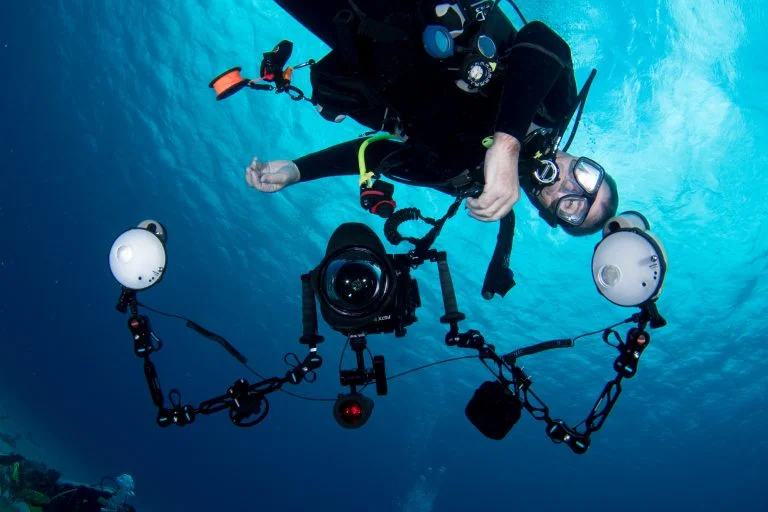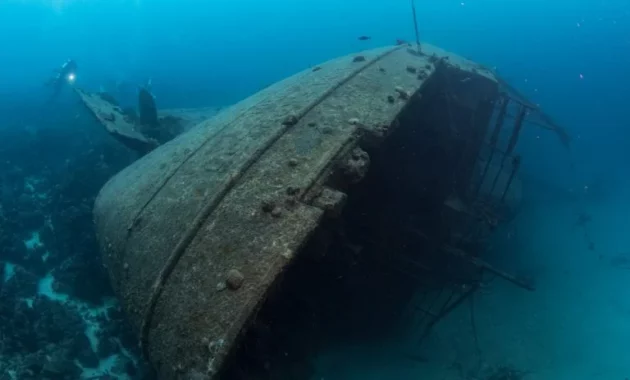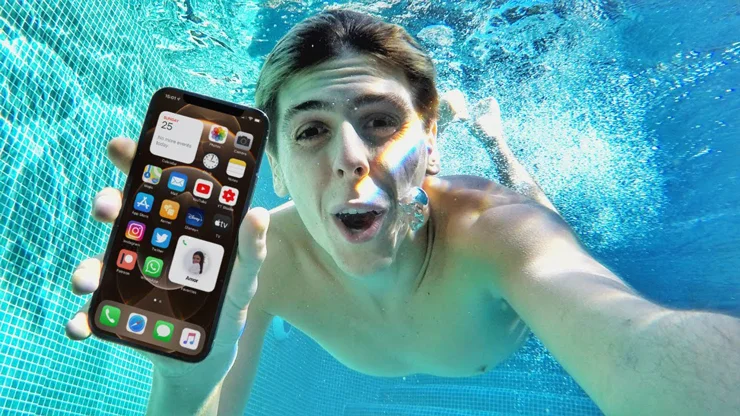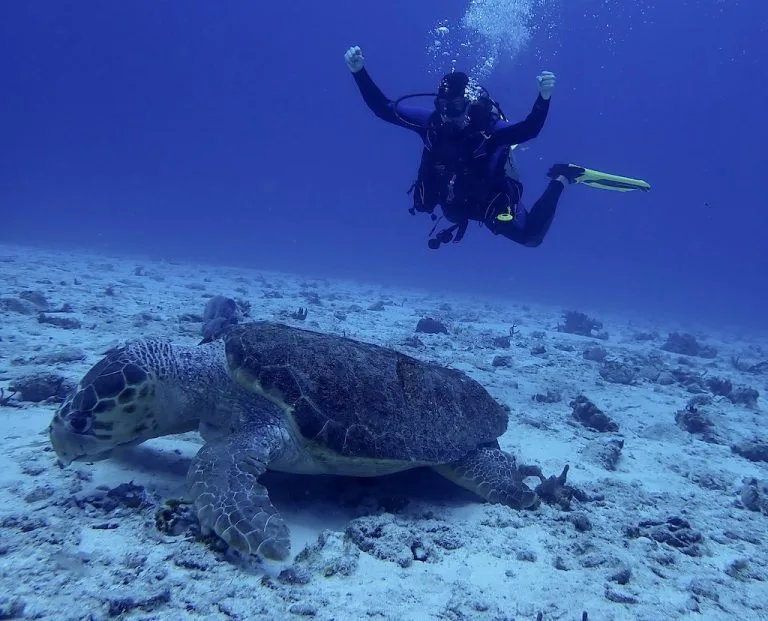This may be the most frequently asked question by divers venturing into the exciting world of underwater photography – What are the best settings for underwater photography? The hard truth is that there isn’t one magical setting that will make all your photos look like David Doubilet‘s… You will have to master several techniques to cover all the different shooting conditions and like always – practice makes perfect! The more you shoot, the more you practice, the better you’ll become and soon enough you’ll feel comfortable changing these settings even several times during the dive.
The good news is that there are only a few basic scenarios you need to prepare for, which require completely different settings. The rest is just fine-tuning.
Before we go over the scenarios, I would like you to do 2 things for me:
Read about the following terms in Google:
- Shutter Speed
- Aperture
- ISO
- White Balance
- Exposure Compensation
Find them in your camera. Learn to identify their units and how to adjust them in Manual and Aperture Priority mode, or how to simply monitor them in Auto and Program modes.
I would gladly explain these terms here, but since they have to do with general photography, others have explained them far better than I can, and we’d rather concentrate on the Underwater settings, which is why you’re here!
…. Ok, you’re back? Great! Let’s start!
Before diving into the more variable settings, I’d like to go over the initial settings which are quite similar in every shooting mode.
Disclaimer: I should note that when writing this, I was using the Canon G7X II and Sony RX100 IV as reference, since they are the most popular compacts in the market at this time.
Most, if not all of this article is still very relevant to other compact camera models as well as mirrorless, and even DSLR’s.
Other brands might call the settings below by different names, but the concepts remain the same.
Note: Advanced photographers might not always agree with the guidelines below, since a deeper understanding of photography may allow you to use different settings than those listed below and still get amazing results. This article is aimed towards beginners who are making their first steps in UW photography and they would benefit the most out of following these guidelines.
- Important Menu Settings for Underwater Photography
- Bright Daylight dive, Good Viz, No Strobe
- Twilight Dive / Low Viz / Deeper than 66ft, No Strobe
- Using an external strobe (or two)
- TTL Flash Exposure
- Non-TTL Flash Exposure
- Using the pop-up / built-in flash
- Night Dives
- Shooting photos with a video light (Macro & Close-ups)
- Summary
Important Menu Settings for Underwater Photography
RedEye Reduction – OFF.
No redeye problem underwater and this will mess up your strobe function.
AF Assist Beam (Canon) / AF illuminator (Sony) – OFF
This is the tiny LED that lights up in dark places to help the camera focus. While it would be nice to have this, it’s usually blocked by the housing, so no need for it here.
Quality – RAW (more about shooting RAW here).
If you’re not yet comfortable shooting RAW, make sure you’re on L / Super Fine JPG, to maintain the highest quality.
ISO – Never ever use Auto ISO when shooting stills!! I have seen countless photographers make this mistake. Even if your camera is set to manual mode, if you use Auto ISO you are letting the camera adjust ISO as it desires, which basically bypasses your manual settings. This means your photos will most likely turn out bad.
Metering Mode – Multi / Evaluative.
This is the default setting and most common. Some photographers like using a different setting here, but if you’re not sure what it does, stick to the one mentioned here.
Focus Mode – AF-S Single (One Shot) / AF-C Continuous (Servo) / AF-A Auto
This is a matter of personal preference. I prefer AF-S Single in most cases. If you like tracking your subject before snapping the shot, use AF-C. Use AF-A if you really trust your camera.
Focus Area – Flexible Spot / Center
This is usually the best setting, since other modes includes automatic selection of the focus point, or face recognition, both of which are not useful or reliable underwater.
Custom Buttons – Personal preference.
Many cameras allow customizing one, two or more buttons to your liking. Assigning things like WB, back-focus, flash compensation and other handy functions to the C button can help you reach those settings faster underwater, with one click.
Back focus is something worth noting; this basically means that you’re moving the half-press action, which tells the camera what to focus on, to a button on the back of the camera.
This is very common among underwater photographers, since the half-press is often hard to control through the housing or with gloves. It’s not easy to get used to shooting with two buttons (thumb first, index finger second), but once you get the hang of it, it should come pretty natural.
Now that we’re all on the same page, here are the most common scenarios:
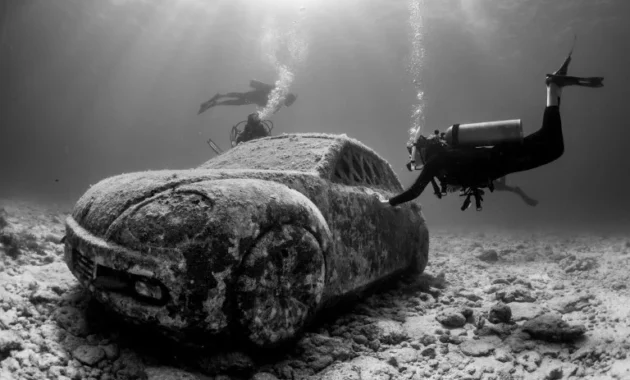
Bright Daylight dive, Good Viz, No Strobe
This is the most common dive you might encounter. You’re somewhere in the Caribbean, with your brand new Canon G7X, Sony RX100 IV or any other compact / mirrorless camera. You haven’t bought a strobe yet because you preferred to start easy, before investing too much in this, but you still want to get good shots!
In this mode you may shoot photos from any distance, either far or close.
Recommended mode – Aperture Priority (AV / A)
Aperture – f/5.6 is usually a good sweet spot.
ISO – 200-800 (depending on depth, the deeper you go, the higher ISO)
WB – Underwater*.
Flash – Off
* White Balance Underwater – If no underwater WB mode exists, there are several other tactics you can use:
- Slate method – take a white slate with you on the dive. Use custom WB to sample the slate several times during the dive, as you change your depth, so that the camera “learns” the colors at that depth and adjusts accordingly.
- Manual Temperature setting – some cameras allow adjusting the WB manually, which goes by K units (5000K, 7500K, 10000K etc.). The deeper you go, the higher you want this to be. If the camera allows, set the tint towards pink (magenta) and red (amber) as well.
Important Note – 90% of the trashed photos in this scenario result from the same thing – blurry photos due to incorrect shutter speed. It’s crucial that you notice which shutter speed your camera is using when you take the shots and make sure it’s fast enough to avoid blurry photos. Ideally it should be faster than 1/200. If it isn’t, raise your ISO.
Twilight Dive / Low Viz / Deeper than 66ft, No Strobe
I’m grouping all of the above conditions together, as they require similar settings.
Basically, in this situation you have less available light to shoot with and no strobe to help you out. You want to allow the most light through your lens, and make sure the shutter speed is fast enough to prevent blurry photos.
This is one of the hardest situations for an underwater photographer, and occasionally it will be close to impossible to get a good shot. If you feel that all your photos are turning out terrible, perhaps it’s time to lower the camera and enjoy the dive without it…
Recommended mode – Aperture Priority (AV / A)
Aperture – Widest possible. F/1.8 – F/2.8 will usually be your choice, depending on the camera model.
ISO – 800-3200 (depending on depth, the deeper you go, the higher ISO)
WB – Underwater*. See note above if no UW mode exists. You will most likely need to correct the tint even more towards Magenta.
Flash – Off
Important Note – 90% of the trashed photos in this scenario result from the same thing – blurry photos due to incorrect shutter speed. It’s crucial that you notice which shutter speed your camera is using when you take the shots and make sure it’s fast enough to avoid blurry photos. Ideally it should be faster than 1/200. If it isn’t, raise your ISO.
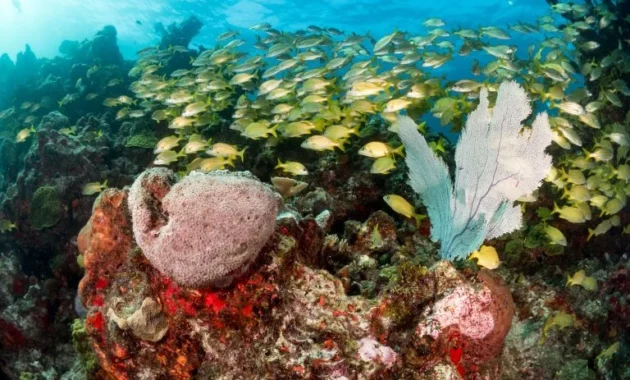
Using an external strobe (or two)
Many divers starting out with UW photography will be tempted to set everything on Auto. Camera on Auto, strobe on TTL and jump in the water!
While that is indeed the easiest way, it will rarely produce the results you are looking for.
The problem is that most of these cameras (Sealife excluded), have engineered their Auto modes to identify most land photography situations and adjust accordingly, but they put little thought to underwater scenarios.
When faced with the underwater world, the camera often gets confused and uses wrong settings, resulting in blurry / overexposed photos, random use of the flash and wrong flash output if used.
In reality, just by following a few easy guidelines, you can use your camera on fully manual mode, with minor adjustments during the dive, and get far better results, even with little prior knowledge in photography. Especially when using an external strobe.
Recommended mode – Manual (M)
Aperture – f/5.6-f/8
Shutter Speed – 1/250 – 1/2000. You can fully control your background by changing the shutter speed only. The faster the shutter speed, the darker your background will be. e.g. 1/2000 for black background, 1/1000 for dark blue background, 1/ 250 for bright blue background. The shutter speed determines how much ambient light you’re letting in, while your subject is lit by the flash.
For shallow depth and better viz, you would likely need a faster shutter speed (1/1000 – 1/2000).
NOTE – This is where a compact operates differently from a DSLR and some Mirrorless cameras. A compact is not limited by Maximum Flash Sync Speed, so it allows you to use very fast shutter speeds with a flash. A DSLR will not allow that due to the type and design of the shutter. This is actually an advantage compact cameras have over DSLR’s!
ISO – 200-800 (depending on depth, the deeper you go, the higher ISO)
WB – Auto WB (AWB)
Flash – On / Fill Flash / Forced On – all of these modes should work, depending on your camera model.
External flash settings – this is a tricky one. We’ll divide this to TTL / Non-TTL.
TTL Flash Exposure
If your flash offers TTL, it will mimic the action of the camera’s built-in flash, and fire the correct amount of light to get proper exposure on your subject.
If TTL is performing as it should, then simply set the strobe on TTL mode, using the above settings and shoot away! Remember that TTL works better up close than on wide angle shots.
** Note – some cameras, such as the Canon G15 and G16, don’t support TTL flash in manual mode. In that case, you can either set your mode to TV (shutter priority) and adjust the shutter according to the background, or use the method below for Non-TTL flash.
For more info on TTL, read this post.
Non-TTL Flash Exposure
In this case you will be setting the strobe power manually using the power dial. This is not as hard as it seems, and it’s often easier than using TTL, if TTL is acting up. Another advantage is lower battery consumption on the camera, since you can set your built-in flash to the minimum output, without affecting the strobe’s output.
- First, set your strobe on the right pre-flash mode to work with your camera. You will usually have two modes – with pre-flash or no pre-flash. One will work and sync with the flash, and the other will come out dark. Use the one that works!
- Second, set your built-in flash to minimum output. That can usually be done in the menu, under flash output or flash compensation.
While shooting, you can easily notice if your flash is too strong or too weak, and change the dial accordingly. I find myself often shooting on full power, or one step lower, when shooting wide angle / medium range, and when shooting macro, I would usually have the dial in the middle or lower.
The distance of the flash is also very important. The further it is from the subject, the stronger you need to fire it. We often place our camera very close to the subject, and forget the strobe is much higher up, or to the side, resulting in a dark photo.
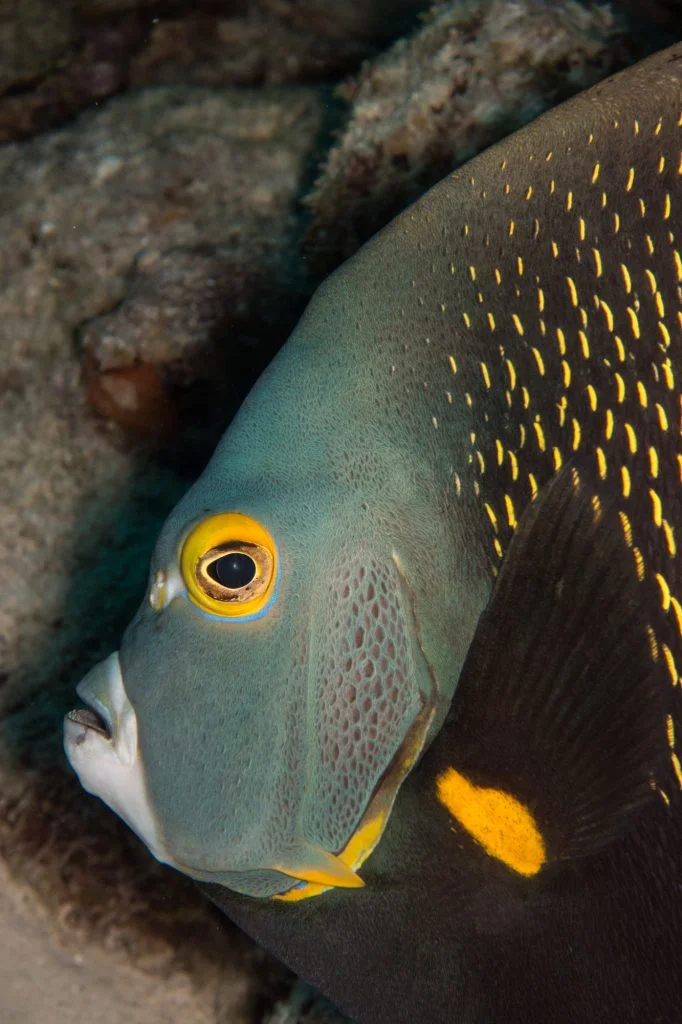
Using the pop-up / built-in flash
All compact cameras include a small pop-up / built-in flash, which is usable in some housings. First of all, check if your housing allows use of this flash. Second, if you have a diffuser that came with the housing – use it! It’s crucial for the light to go past the port of the housing, otherwise you will get a big chunk of shadow on the bottom part of your image. The diffuser also helps “diffuse” the light by enlarging your light source and preventing harsh shadows.
There are two major problems with using the internal flash:
- Backscatter – the underwater photographer’s nemesis. Backscatter will show when the light source is close to the camera lens, as it is in this case. These are reflections from the particles in the water.
- Power – the internal flash is rather weak and isn’t effective further than 1-2 feet.
Due to the 2 problems listed here, I recommend using the pop-up flash only on subjects closer than 2 feet, and the closer the better. If the visibility is bad, I would shoot no further than 1 ft away! Otherwise, backscatter will ruin your shot.
The recommended camera settings would be similar to those listed above for an external flash. The main difference is the distance from your subject, which can be up to 5-6 feet with an external flash, but only 1-2 feet with the pop-up flash.
This mode is great for macro! Just make sure that when using an external close-up lens, it does not obstruct your flash.
Recommended mode – Manual (M)
Aperture – f/2.8 (this is a large aperture, to let in more light)
Shutter Speed – 1/250 – 1/2000. You can fully control your background by changing the shutter speed only. The faster the shutter speed, the darker your background will be. e.g. 1/2000 for black background, 1/1000 for dark blue background, 1/ 250 for bright blue background. The shutter speed determines how much ambient light you’re letting in, while your subject is lit by the flash.
For shallow depth and better viz, you would likely need a faster shutter speed (1/1000 – 1/2000). Especially since your aperture is set to let in more light.
ISO – 200-800 (depending on depth, the deeper you go, the higher ISO)
WB – Auto WB (AWB)
Flash – On / Fill Flash / Forced On – all of these modes should work, depending on your camera model.
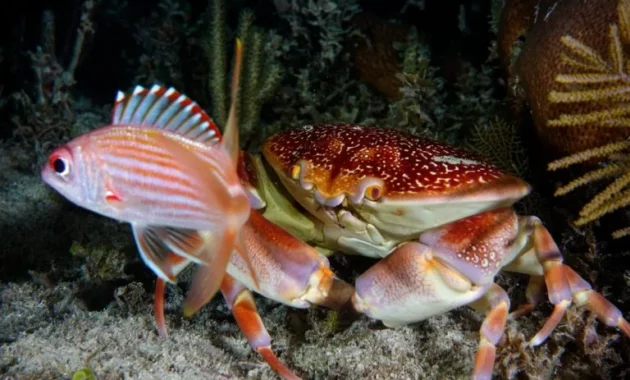
Night Dives
While this is a more adventurous type of diving, the photography part is actually easier, since you have no ambient light to work with and balance! The only light you will use, is the one created by you, making it much easier to control.
The secret to good photos at night is a good focus light. Without a focus light, your camera is blind. It will hunt for focus and refuse to shoot, or even worst, take blurry out-of-focus shots.
Ideally, you can get a focus light that switches off when the strobe flashes, so that its beam won’t interfere with the shot and the subject will be lit by the strobe alone. Look for the AFO (Auto Flash Off) feature when choosing a focus light.
Another great feature is using red light for focus. The camera is very sensitive to red light, so it can easily focus using only that. Most marine life can’t see red light at all. It just isn’t in their visible spectrum. This fact helps you get much closer to fish and critters, without spooking them away with your bright light. The red light will most likely not show up in the photos as well, so you don’t need to worry about canceling it out.
On the other hand, it is harder for us humans to notice things under red light, which is why many still prefer a white light over red.
Once your camera can focus, all you need to do is light the subject with your strobe. Shutter speed doesn’t matter here that much and other settings are fairly straightforward.
Recommended mode – Manual (M)
Aperture – f/5.6 – f/8
Shutter Speed – 1/250s. If you’re using a white focus light that doesn’t turn off automatically, use a faster shutter speed to get rid of it in the shot – 1/1000s or so.
ISO – 200. Maintain the best image quality.
WB – Auto WB (AWB).
Flash – On / Fill Flash / Forced On – all these modes should work, depending on your camera model.
Strobe – If your camera and flash support TTL, that’s best for night dives. Otherwise, set the flash on medium power and adjust as needed.
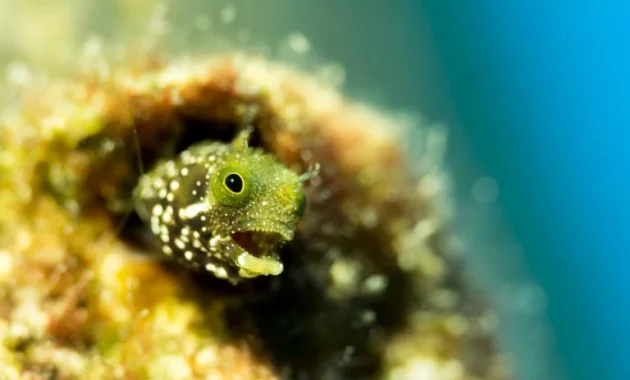
Shooting photos with a video light (Macro & Close-ups)
A few years back, video lights were either huge and expensive, or small and weak.
In the last couple of years, we’re seeing a boom in LED technology, resulting in more affordable, more compact and more powerful underwater video lights and dive lights. This still doesn’t mean you can ditch your strobe and shoot with LED lights only, since strobes still produce about 10 times more light than an equivalent video light around the same price range. However, video and dive lights are a good alternative for lighting and often easier to use and more accessible.
The secret to shooting photos with video lights is to stay close! Don’t try to shoot anything with a video light further than 1-2ft.
Keeping your subject under 1 foot away is ideal. That’s why video / dive lights are great for macro.
The main advantage, is that you don’t have to worry about recycle speed, which slows you down, so you can shoot in continuous / burst mode. This way it’s more likely one of your shots will be in perfect focus and capture the precise moment that little Blenny yawns or the Arrow Crab stuffs food in his little mouth.
Recommended mode – A / AV (aperture priority)
Aperture – depends on your light. If you have a strong light (3000+ lumens), you can “afford” a smaller aperture (f/8 – f/16). Otherwise, use f/2.8 – f/4.
Shutter Speed – Will be chosen automatically by the camera. Make sure it’s faster than 1/100s to freeze movement. Over 1/200s is even better.
ISO – 400-1600 (The stronger your light is, the lower ISO you can use)
WB – The best way is to use a slate and set custom WB by shining your light at it. Otherwise, use Auto WB (AWB).
Flash – Off of course.
Shooting mode – Continuous / Burst. Capture several images to make sure one is in focus.
Metering – It might be a good idea to use Spot or Center metering in this case, especially if using a narrow beam light. This will make sure exposure is metered from the center of the frame, preventing over-exposure of your subject.
IMPORTANT – This technique is more prone to blurriness than using a strobe, so make sure you review the photos immediately after taking them, while still with the subject, and zoom into them on your LCD screen, to make sure they’re in focus and not blurry. Otherwise, try again!
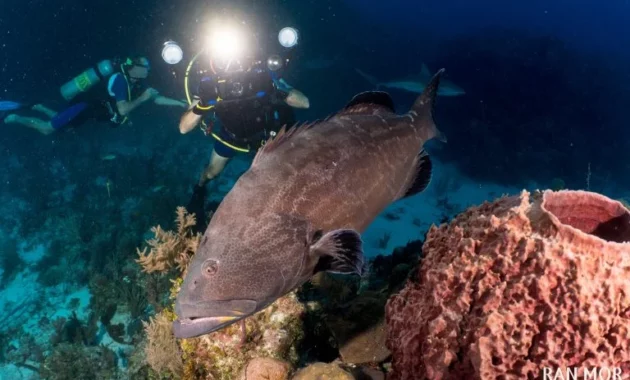
Summary
These scenarios should cover 90% of the conditions you will encounter on your dives. The remaining 10% may require a more creative, out-of-the-box thinking, and after gaining a deeper understanding in camera settings and getting to know your camera better, you should be able to adjust your settings to almost every situation you’re faced with!
In general, I don’t recommend messing around with camera settings too much during a dive. To make your dive more enjoyable, and less risky, adjust everything in advance. Perhaps you can prepare one additional setting to use during the dive. Practice several times before the dive on adjust that setting, and which buttons you will need, so you don’t start looking for them underwater while smashing into corals and losing your dive buddy.
Have you encountered a situation that I didn’t cover in this post? Can’t find the settings on your camera? Need more advice? Contact me at ran@housingcamera.com! I’m always happy to help 🙂

